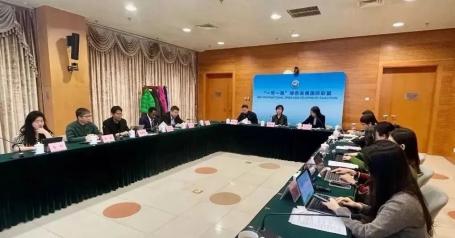WRI Co-hosts Briefing Event of Key Outcomes on Green Development Yielded at the 3rd BRI Forum - the Green Path Ahead with BRI Participating Countries
In a significant milestone, the third Belt and Road Forum for International Cooperation Forum (hereinafter referred as the 3rd BRF) and the 28th Conference of the Parties to the United Nations Framework Convention on Climate Change (COP28) recently concluded, marking a collective effort to expedite global low-carbon transformation and tackle the climate crisis. Notably, various outcomes from the BRI Forum were introduced and deliberated upon during COP28. Accelerating renewable energy development has become a shared focus of global climate action and the green development of the Belt and Road Initiative (BRI).
In a proactive effort to advance progress in the renewable energy sector and foster collaboration in energy transition between China and BRI participating countries, especially those from Africa and Southeast Asia, the BRI International Green Development Coalition (BRIGC) and the World Resources Institute (WRI) co-hosted the “the Green Path Ahead with BRI Participating Countries” on December 14 in Beijing. CUI Dandan, Secretary-General of BRIGC, delivered an opening remark. MIAO Hong, Senior Associate and Director of Sustainable Investment Program at WRI, moderated the meeting. Representatives from the National Development and Reform Commission (NDRC), Ministry of Ecology and Environment (MEE), China Renewable Energy Engineering Institute (CREEI), embassies of African and Southeast Asian countries in China, and Chinese financial institutions were invited and actively participated in discussions.
The exchange primarily centered on aligning resource information and fostering profound collaboration between China and BRI participating countries. The event focused on four government-level outcomes related to green development arising from the 3rd BRF, featured briefing sessions delivered by speakers who are leading or engaged in implementation of the four outcomes. Speakers deliberated the outcomes and shared their future work plan with participants. The outcomes covered various facets of clean energy transformation, such as facilitating renewable energy project development at the regional, country and city level, exploring new solutions to support the growth of renewable energy through official aid and green financing. In the discussion section followed, participants shared their experiences, needs, and ideas for concrete cooperation and offered suggestions.

Belt and Road Initiative for Sustainable Development of Twenty Cities
Speaker: China Center for Urban Development of the NDRC
The initiative, as one of the listed outcomes of the 3rd BRF, is poised to be officially launched by the Belt and Road Sustainable Cities Alliance, in collaboration with domestic and international cities and partner institutions. This initiative focuses on six major themes for cities including livable, resilient, innovative, smart, green and humanistic. Its aim is to foster a consensus on sustainable urban development, share emerging concepts, exemplary cases, and solutions for green and low-carbon urban transformation, and promote practical cooperation among cities both domestically and internationally.
Green Investment and Finance Partnership
Speaker: the BRI International Green Development Coalition
Jointly launched by the BRIGC in collaboration with Chinese and international partners at the High-Level Forum on Green Development of the 3rd BRF, the partnership aims to leverage the professional strengths of partners to facilitate cooperation for green development, explore green investment and project evaluation and improve the integration of project management with ESG assessment. It intends to create a platform for communication and collaboration, as well as provide practical solutions to remove the bottlenecks in financing for a greener BRI.
Africa Solar Belt Program as part of the South-South Cooperation on Climate Change
Delegate speaker: The Foreign Environmental Cooperation Center of the MEE
The Africa Solar Belt Program, initiated by the Department of Climate Change of the MEE, aims to implement the Declaration on China-Africa Cooperation on Combating Climate Change. The program focuses on unleashing Africa's solar potential and fulfilling the collaboration needs between China and Africa on clean energy, by leveraging China’s advantages in the solar industry. Through a collaborative approach involving "Goods and Material Projects + Dialogues + Joint Research + Capacity Building" the project aims to develop a batch of climate-friendly, “small and beautiful” and people-centered "solar-integrated" projects. WRI provides technical support for the initiation and implementation of the Africa Solar Belt Program.
China-AU Energy Partnership
Delegate Speaker: China Renewable Energy Engineering Institute
The China-AU Energy Partnership was jointly launched by the National Energy Administration of China and the African Union Commission. Its objective is to strengthen practical cooperation in the energy sector, collectively increase Africa's electrification levels and the share of clean energy, gradually address energy access, and promote sustainable energy development both in China and AU. Under this parentship, WRI supported the launch of Egypt Initiative on Developing Clean Energy to Improve Electricity Access at COP 27. During COP 28, a project aimed to push for more small-scale innovative renewable energy projects between China and Africa, which is also under the partnership, was officially launched. The project selects innovative cases in energy transition and creative technology solutions with practical potential. It commits to supporting selected cases by facilitating resource connections, thereby promoting the realization of more "small and beautiful" renewable energy projects in Africa.
During the discussions, participants shared their expectations on further realizing or implementing the key outcomes related to green development arising from the 3rd BRF, especially for:
1) China would continue to enhance practical collaboration and dialogue exchanges with African and Southeast Asian countries. All parties would be encouraged to share experiences and insights in order to launch more projects.
2) continuously supporting energy transition in developing countries by devising solutions and investment frameworks tailored to diverse needs in the realm of green and renewable energy. This involves addressing different requirements of various stakeholders.
3) further exploring models that are climate-ecologically, socially and commercially sustainable to accelerate renewable energy development under the BRI, such as the “small and beautiful” project model proposed at the 3rd BRF.